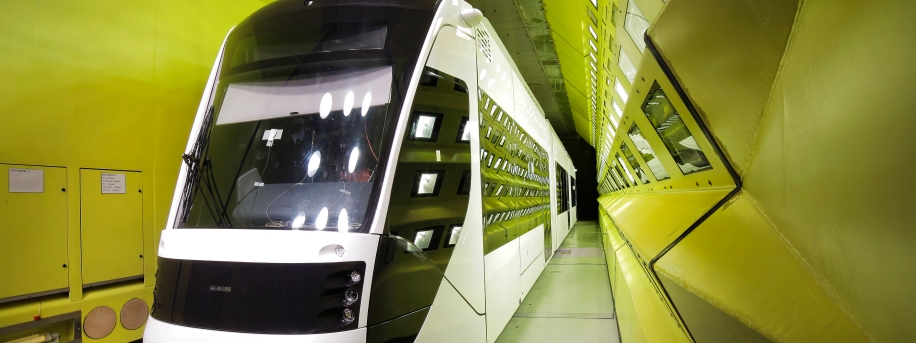
Siemens Tests Tram Designed for Harsh Desert Climates

Siemens is constructing a state-of-the-art turnkey tram system comprising 19 streetcars in Qatar's capital city of Doha. In the picture: the climate-wind tunnel of the Rail-Tec-Arsenal in Vienna, Austria.
Siemens performed the tests at the climate-wind tunnel of the Rail-Tec-Arsenal in Vienna, Austria, where it simulated the streetcar’s operation in Qatar’s summer heat. Despite an exterior temperature of 40 degrees Celsius and 30 percent humidity, the temperature inside the fully occupied streetcar was a comfortable 25 degrees.
In addition, passengers were always supplied with sufficient amounts of fresh air. Although the desert streetcar is based on the Avenio platform, it is also equipped with high-performance air conditioners, special roof-mounted shading systems, and very good insulation.
The Rail-Tec-Arsenal climate test lab, which is partly owned by Siemens, is a unique facility where trains up to 100 meters in length can be subjected to all kinds of weather and operating scenarios. A huge fan generates airstreams, and large fields of intense halogen lamps simulate the sun’s rays.
Users can set the humidity and create rain or snow. Passenger-related effects are simulated by air humidifiers and heat pads on the seats. The doors are opened and closed in accordance with the stops along the streetcar’s future route. To test the streetcar for Qatar, Siemens squeezed a complete 27-meter-long vehicle into the tunnel, where it was subjected to a variety of conditions.
No Overhead Lines Needed
Siemens is building a streetcar route that is more than 11 kilometers long in Qatar’s capital city, Doha. The system will be turnkey-ready and will include all of the associated infrastructure. The project includes the construction of 25 stations and a depot as well as the delivery of 19 state-of-the-art Avenio streetcars.
The Doha streetcar system will be Siemens’ first streetcar route to operate without overhead lines. The vehicles will instead be equipped with energy storage devices that will recharge themselves at stops through special roof conductor rails. The streetcar system is scheduled to enter service in 2016.
To accomplish this, Siemens developed the Sitras HES hybrid energy storage device, which combines a double-layer capacitor with a nickel-metal hydride battery. The storage device enables the streetcar to travel without overhead lines and also to recover braking energy.
As a result, a typical streetcar’s energy demand may be reduced by up to 30 percent and its CO2 emissions by up to 80 metric tons. The storage device enables the streetcar to travel up to 2.5 kilometers before it has to be recharged.
To ensure that the new streetcar route in Qatar requires no overhead lines, the distances between stops do not exceed this maximum range. The streetcar consumes electricity from the grid when it begins to move, as this requires an especially large amount of energy. After that, the electricity is supplied by the energy storage devices. In the climate-wind tunnel, Siemens also tested the charging cycles of the energy storage system under all of the climate conditions that are expected to occur in Qatar.
Christine Rüth
Mr. Dr Norbert Aschenbrenner
Editorial Office
Siemens AG
norbert.aschenbrenner@siemens.com
Mr. Florian Martini
Journalist Inquieries
Siemens AG
florian.martini@siemens.com












